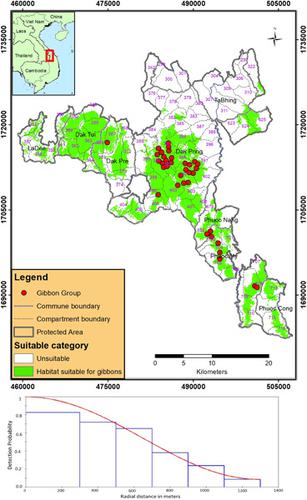当前位置:
X-MOL 学术
›
Am. J. Primatol.
›
论文详情
Our official English website, www.x-mol.net, welcomes your
feedback! (Note: you will need to create a separate account there.)
Combining species distribution modeling and distance sampling to assess wildlife population size: A case study with the northern yellow-cheeked gibbon (Nomascus annamensis).
American Journal of Primatology ( IF 2.0 ) Pub Date : 2020-06-30 , DOI: 10.1002/ajp.23169 Dung Van Tran 1, 2 , Thinh Tien Vu 1, 3
American Journal of Primatology ( IF 2.0 ) Pub Date : 2020-06-30 , DOI: 10.1002/ajp.23169 Dung Van Tran 1, 2 , Thinh Tien Vu 1, 3
Affiliation

|
Population size and distribution data for wildlife species play an important role in conservation and management, especially for endangered species. However, scientists seriously lack data on the population status of many species. The northern yellow‐cheeked gibbon (Nomascus annamensis) is found in southern Lao PDR, central Vietnam, and northeastern Cambodia. The population of the species has significantly declined due to hunting, habitat loss, and the wildlife trade. To examine the population size and distribution of N. annamensis, we conducted a field survey in Song Thanh Nature Reserve, Quang Nam Province, central Vietnam from February to April 2019 using the audio point count method. We combined Distance Sampling and Ecological Niche Modeling to estimate the population of the gibbons. Results showed that the total suitable area for the gibbons was about 302.32 km2, with the two most important variables of the habitat model being the distance‐to‐villages and forest type. We detected 36 gibbon groups through field surveys and estimated 443 (95% CI, 278–707) gibbon groups in Song Thanh Nature Reserve. Our results indicate that the gibbon population in Song Thanh Nature Reserve is the largest known population of N. annamensis in Vietnam. In addition, our study was the first to combine species distribution modeling with distance sampling to estimate gibbon density and population size. This approach might be useful in surveying and monitoring gibbon populations because it takes imperfect detection probability into account in estimating gibbon population density while estimating the area of potential habitat using environmental variables.
中文翻译:

结合物种分布模型和距离采样来评估野生动植物种群数量:以北部黄颊长臂猿(Nomascus annamensis)为例。
野生动植物物种的种群规模和分布数据在保护和管理中,特别是在濒危物种的保护和管理中,发挥着重要作用。但是,科学家严重缺乏有关许多物种的种群状况的数据。北部的黄颊长臂猿(Nomascus annamensis)位于老挝人民民主共和国南部,越南中部和柬埔寨东北部。由于狩猎,生境丧失和野生动植物贸易,该物种的种群已大大减少。调查南山猪笼草的种群规模和分布,我们于2019年2月至2019年4月在越南中部广南省Song Thanh自然保护区进行了实地调查,采用的是音频点计数方法。我们结合了距离采样和生态位生态模型来估计长臂猿的种群。结果表明,长臂猿的总适宜面积约为302.32 km 2,生境模型的两个最重要变量是到村庄的距离和森林类型。通过实地调查,我们发现了36个长臂猿类群,并估计了Song Thanh自然保护区中的443个长臂猿类群(95%CI,278-707)。我们的结果表明,宋丹自然保护区的长臂猿种群是已知的南安奈斯猪种群最大的种群。在越南。此外,我们的研究是第一个将物种分布模型与距离采样相结合以估计长臂猿密度和种群规模的研究。这种方法可能在调查和监视长臂猿种群中很有用,因为它在评估长臂猿种群密度时会考虑不完善的检测概率,同时使用环境变量来估计潜在的栖息地面积。
更新日期:2020-08-26
中文翻译:

结合物种分布模型和距离采样来评估野生动植物种群数量:以北部黄颊长臂猿(Nomascus annamensis)为例。
野生动植物物种的种群规模和分布数据在保护和管理中,特别是在濒危物种的保护和管理中,发挥着重要作用。但是,科学家严重缺乏有关许多物种的种群状况的数据。北部的黄颊长臂猿(Nomascus annamensis)位于老挝人民民主共和国南部,越南中部和柬埔寨东北部。由于狩猎,生境丧失和野生动植物贸易,该物种的种群已大大减少。调查南山猪笼草的种群规模和分布,我们于2019年2月至2019年4月在越南中部广南省Song Thanh自然保护区进行了实地调查,采用的是音频点计数方法。我们结合了距离采样和生态位生态模型来估计长臂猿的种群。结果表明,长臂猿的总适宜面积约为302.32 km 2,生境模型的两个最重要变量是到村庄的距离和森林类型。通过实地调查,我们发现了36个长臂猿类群,并估计了Song Thanh自然保护区中的443个长臂猿类群(95%CI,278-707)。我们的结果表明,宋丹自然保护区的长臂猿种群是已知的南安奈斯猪种群最大的种群。在越南。此外,我们的研究是第一个将物种分布模型与距离采样相结合以估计长臂猿密度和种群规模的研究。这种方法可能在调查和监视长臂猿种群中很有用,因为它在评估长臂猿种群密度时会考虑不完善的检测概率,同时使用环境变量来估计潜在的栖息地面积。











































 京公网安备 11010802027423号
京公网安备 11010802027423号